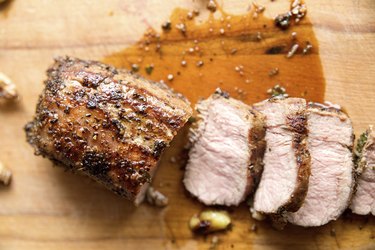
Making last night's roast into today's lunch and dinner leftovers not only saves time, but it also eliminates waste. That said, knowing how to tenderize a tough roast that is already cooked requires patience and some mad skills in the kitchen.
Tip
A good liquid base is the best place to start when it comes to fixing a dried-out roast.
Video of the Day
Tenderize a Cooked Roast
There are a few ways to tenderize a tough roast that is already cooked. Claudia Sidoti, the head chef and head of recipe development at HelloFresh, tells LIVESTRONG.com that the best way to tenderize meat is to cook it again. She also recommends sticking with a liquid such as half wine and half broth instead of a sauce because the sauce is more likely to burn. This can also help when moistening a dry ham is in order.
Video of the Day
Chef Michael Ollier, senior corporate chef for the Certified Angus Beef brand, tells LIVESTRONG.com that if you have a tough or dry roast, there are a few things you can do to salvage your meal. "If it's a roast that you were oven roasting like a rib roast, a strip roast, a tenderloin roast or a top sirloin roast, slice it as thinly as you can against the grain," he says. Then, gently simmer the sliced meat in a pan with beef broth for 20 to 30 minutes and you can enjoy it as a sandwich.
A chuck or round roast, such as our Healthy Crock Pot Roast, that's cooked in liquid, may be tough if it doesn't cook long enough. These cuts break down with long cooking times at low temperatures.
In this case, Ollier recommends cutting the roast into smaller cubes and cooking the cubes in broth in a Dutch oven with the lid closed at 275 degrees Fahrenheit until it shreds easily. The result will be more like a stew or shredded beef than a sliceable roast.
Fix a Dried-Out Roast
When it comes to tasty leftovers, eating dried-out meat is not a fan favorite. The good news? With a few extra steps, you can take a day-old, dry roast and make it moist and juicy again.
One of the easiest ways, says Sidoti, is to use a slow cooker or pot with a lid.
- Place meat in the slow cooker or pot.
- Add 2 to 3 cups of liquid (your choice) with enough to cover about halfway but not fully. Make sure to select a liquid that helps bring out the flavors of any seasonings you've already used. For example, beef broth and red wine rather than a sauce. Sometimes sauce has flour or cornstarch and those may burn with long slow cooking.
- Simmer the meat until you test for tenderness with a fork. Schedule six to eight hours in a slow cooker or two hours in an oven at 350 F.
- Do not let the liquid come to a boil. Add more liquid if necessary.
Reheating and Food Safety
When recooking undercooked pork or any other meat, it's essential that you know the safe internal cooking temperatures before eating the meat. The Academy of Nutrition and Dietetics says steaks, roasts and chops need to reach an internal temperature of 145 F and allowed to rest for at least three minutes before carving or consuming.
To test for doneness and safety, the USDA Food Safety and Inspection Service recommends inserting a dial or digital meat thermometer into the thickest part of the food, making sure it doesn't touch bone, fat or gristle.
If you eat meat that hasn't reached an internal temperature of 145 F, you risk contracting a foodborne illness. According to the Mayo Clinic, most often food poisoning is mild, but there are times when the symptoms require immediate medical attention.
Some of the more serious symptoms to be aware of include frequent episodes of vomiting, watery or bloody diarrhea for more than three days, abdominal pain or cramps, and fever. If these symptoms are present, call your doctor.
- Academy of Nutrition and Dietetics: "Complete List of Cooking Temperatures"
- Mayo Clinic: "Food Poisoning"
- HelloFresh: "Head Chef, Claudia Sidoti: Personal Interview"
- Certified Angus Beef: "Senior Corporate Chef, Michael Ollier: Personal Interview"
- USDA Food Safety and Inspection Service: "Doneness Versus Safety"